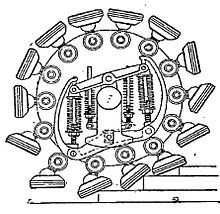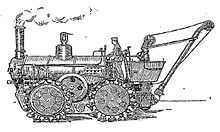Pedrail wheel

The pedrail wheel is a type of wheel developed in the early 20th century for all-terrain locomotion. It was used in agricultural machinery. Pedrail wheels should not be confused with Dreadnaught Wheels which have articulated rails attached at the rim for the wheel to roll over (also known as endless railway wheels).
Definition
According to the 1913 Webster's Revised Unabridged Dictionary, a pedrail is:
A device intended to replace the wheel of a self-propelled vehicle for use on rough roads and to approximate to the smoothness in running of a wheel on a metal track. The tread consists of a number of rubber shod feet which are connected by ball-and-socket joints to the ends of sliding spokes. Each spoke has attached to it a small roller which in its turn runs under a short pivoted rail controlled by a powerful set of springs. This arrangement permits the feet to accommodate themselves to obstacles even such as steps or stairs.
Invention

The pedrail wheel was invented in 1903 by the Londoner Bramah Joseph Diplock.[3][4] It consists in the adjunction of feet (Latin radical "ped") to the rail of a wheel, in order to improve traction and facilitate movement in uneven or muddy terrain.[1] Sophisticated pedrail wheels were designed, with individual suspension for each foot, which would facilitate the contact with uneven terrain.
Bramah Joseph Diplock also invented the pedrail locomotive which was featured in 7 February 1904 New York Times.[1]
Fiction

H. G. Wells, in his short story The Land Ironclads, published in The Strand Magazine in December 1903, described the use of large, armoured cross-country vehicles, armed with automatic rifles and moving on pedrail wheels, to break through a system of fortified trenches, disrupting the defence and clearing the way for an infantry advance:
They were essentially long, narrow and very strong steel frameworks carrying the engines, and borne upon eight pairs of big pedrail wheels, each about ten feet in diameter, each a driving wheel and set upon long axles free to swivel round a common axis. This arrangement gave them the maximum of adaptability to the contours of the ground. They crawled level along the ground with one foot high upon a hillock and another deep in a depression, and they could hold themselves erect and steady sideways upon even a steep hillside.
In War and the Future, Wells acknowledged Diplock's pedrail as the origin for his idea of an all-terrain armoured vehicle:[6]
The idea was suggested to me by the contrivances of a certain Mr. Diplock, whose "ped-rail" notion, the notion of a wheel that was something more than a wheel, a wheel that would take locomotives up hill-sides and across ploughed fields, was public property nearly twenty years ago
Although Wells describes the pedrail wheels in detail, a number of authors have mistakenly taken his description to be of some form of caterpillar track. Diplock's version of an endless track was not designed until some ten years after the publication of Wells' story. The pedrail wheel played no part in the design of the first British tanks.
Abandonment of the Wheel and development of the Chaintrack
In 1910 Diplock abandoned the Pedrail Wheel and began developing what he called the Chaintrack, in which fixed wheels ran on a moving belt, very like the caterpillar track as it is now understood.[8] It was a complicated and high-maintenance system, and in 1914 Diplock eventually produced a version on a simpler, single wide track.[9] With a body fitted, the machine could carry a ton of cargo and be pulled with minimal effort by a horse. It demonstrated the attributes of the caterpillar track: low friction and low ground pressure.
World War I

During World War I, as trench warfare immobilized the front, a number of proposals were made for machines that could cross no-man's-land to enemy lines, and experiments were conducted with the Pedrail system.
In January 1915 Flight Commander Thomas Hetherington of the Royal Naval Air Service saw a demonstration of one of Diplock's tracked trucks, was impressed by its manoeuvrability, and bought it, with a view to mounting a bullet-proof shield for protecting infantry. During the discussions that led to the formation of the Landships Committee, Hetherington showed the truck to Winston Churchill, who found he was able to pull the fully laden vehicle himself.[10]
The Landships Committee, established by Churchill in February 1915,[11] conducted experiments and tests of various vehicles in its attempts to create an armoured fighting vehicle, and the Pedrail track was amongst the technologies considered. The initial Pedrail design coming from Murray Sueter's discussions with Diplock was for a 25 ton vehicle on two tracks carrying a 12-pounder gun in a turret.[12] In March 1915, RE Compton redesigned it as a 40-foot long vehicle that could carry a storming party of 50 troops protected by 8 mm of armour plate.[12] Churchill ordered the building of 18 experimental landships: 12 using Diplock pedrails, and 6 using large wheels. Construction failed to move forward, as the wheels seemed impractical, and the pedrails met with industrial problems.[13] When these attempts had failed by July 1915, continuous tracks were tested, and they soon became the technique of choice for the development of the tank.[14] The pedrail was considered as too weak for an all-terrain armoured machine, and "caterpillar" continuous tracks were ultimately preferred.[15]
The Pedrail machine contract was initially with Foden but passed to Birmingham Carriage and Wagon (BCW) in April 1915. In order that it would be able to move through French towns and villages, the design was altered to articulate in the middle. It was also reduced in height and side armour increased to 12 mm to give better protection from rifle fire. BCW asked to be released from the contract so they could concentrate on other work, and so the contract — now reduced to one machine — passed on to Fosters of Lincoln. Work stopped on the Pedrail as it was too heavy and better designs were in the offing but the parts already constructed were used by Stothert & Pitt to assemble a flamethrower carrying vehicle for the Trench Warfare Department in 1916. Weighting 32 tons "unladen", it achieved 15 mph from two 100 hp engines.[12]
Notes
- ↑ 1.0 1.1 1.2 1.3 "The Perambulating Pedrail", The New York Times, 7 February 1904.
- ↑ "Pedrail", The Free dictionary.
- ↑ Wallistayler, AJ, p. 271 .
- ↑ Popular Science, Sep 1933, p. 96.
- ↑ Wells, HG (December 1903), The Land Ironclads, Zeitcom, §4.
- ↑ Wells, p. 93.
- ↑ Wells 2004, p. 93.
- ↑ Diplock's 1910 patent
- ↑ Diplock's 1914 patent.
- ↑ Example of truck demonstrated to Churchill.
- ↑ Van Lee, Vin Rouge, Vin Blanc, Beaucoup Vin, the American Expeditionary Force in WWI, p. 162.
- ↑ 12.0 12.1 12.2 White 1963.
- ↑ Harris 1995, pp. [http://books.google.com/books?id=00myJhLVIUUC&pg=PA23 23–24.
- ↑ Men, ideas, and tanks by J. P. Harris, p.27-28
- ↑ Prior, Robin, Churchill's World crisis as history, p. 234.
Bibliography
- Harris, JP (1995), Men, ideas, and tanks: British Military Thought and Armoured Forces, 1903–1939 (HARDBACK), War, Armed Forces and Society 1, Manchester University Press, ISBN 0-7190-3762-X
.
- Wells, Herbert George (30 June 2008) [1917], War and the Future, Kessinger, ISBN 0-497-97078-3.
- White, BT (1963), British Tanks 1915–1945, Shepperton: Ian Allan.
References
- Glanfield, John (2006), The Devil's Chariots: The Birth and Secret Battles of the First Tanks, Sutton Pub, ISBN 0-7509-4152-9.